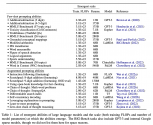Artificial General Intelligence (AGI) is the hypothetical ability of a machine to perform any intellectual task that a human can do. Large language models, such as OpenAI's GPT-3, have demonstrated impressive capabilities in natural language understanding and generation, leading some to speculate about their potential for achieving AGI. However, despite their notable achievements, large language models have inherent limitations that make them unlikely candidates for true AGI. This essay will discuss these limitations, including their lack of reasoning abilities, reliance on massive amounts of data, absence of common sense understanding, and ethical concerns.
A key aspect of AGI is the ability to engage in complex reasoning and problem-solving. While large language models can generate coherent text and answer questions based on the patterns they have learned from their training data, they lack the ability to engage in deductive or inductive reasoning that is essential for AGI. This is because these models primarily rely on pattern matching and statistical associations rather than understanding the underlying logic or principles behind the information they process. Consequently, they are prone to making errors when faced with novel situations or questions that require logical reasoning.
Large language models depend on vast amounts of data for their training, which presents several challenges for achieving AGI. First, the need for extensive data limits the applicability of these models in domains where data is scarce or expensive to acquire. Second, the sheer scale of computational resources required for training large models raises questions about their efficiency and ecological impact. In contrast, humans can learn and generalize from a relatively small number of examples, highlighting the difference between the learning mechanisms of large language models and true AGI.
Common sense understanding is a fundamental aspect of human intelligence, allowing us to make inferences and predictions about the world based on our background knowledge. However, large language models often lack this basic understanding. Despite being trained on vast amounts of text, these models still make mistakes that a human with common sense would not. This is partly because large language models learn from text data alone, which may not fully capture the richness of human experience and understanding. True AGI would require the integration of various types of knowledge, including visual, auditory, and tactile, as well as an understanding of the underlying structure of the world.
While large language models have undoubtedly advanced the field of AI and demonstrated impressive natural language capabilities, they fall short of achieving true AGI due to their lack of reasoning abilities, reliance on massive amounts of data, absence of common sense understanding, and ethical concerns. To reach AGI, researchers must explore alternative approaches that move beyond the limitations of current large language models, incorporating reasoning, efficient learning mechanisms, and a more comprehensive understanding of the world. Addressing the ethical challenges associated with AI development is also crucial to ensure that AGI benefits all of humanity and avoids causing harm.
A key aspect of AGI is the ability to engage in complex reasoning and problem-solving. While large language models can generate coherent text and answer questions based on the patterns they have learned from their training data, they lack the ability to engage in deductive or inductive reasoning that is essential for AGI. This is because these models primarily rely on pattern matching and statistical associations rather than understanding the underlying logic or principles behind the information they process. Consequently, they are prone to making errors when faced with novel situations or questions that require logical reasoning.
Large language models depend on vast amounts of data for their training, which presents several challenges for achieving AGI. First, the need for extensive data limits the applicability of these models in domains where data is scarce or expensive to acquire. Second, the sheer scale of computational resources required for training large models raises questions about their efficiency and ecological impact. In contrast, humans can learn and generalize from a relatively small number of examples, highlighting the difference between the learning mechanisms of large language models and true AGI.
Common sense understanding is a fundamental aspect of human intelligence, allowing us to make inferences and predictions about the world based on our background knowledge. However, large language models often lack this basic understanding. Despite being trained on vast amounts of text, these models still make mistakes that a human with common sense would not. This is partly because large language models learn from text data alone, which may not fully capture the richness of human experience and understanding. True AGI would require the integration of various types of knowledge, including visual, auditory, and tactile, as well as an understanding of the underlying structure of the world.
While large language models have undoubtedly advanced the field of AI and demonstrated impressive natural language capabilities, they fall short of achieving true AGI due to their lack of reasoning abilities, reliance on massive amounts of data, absence of common sense understanding, and ethical concerns. To reach AGI, researchers must explore alternative approaches that move beyond the limitations of current large language models, incorporating reasoning, efficient learning mechanisms, and a more comprehensive understanding of the world. Addressing the ethical challenges associated with AI development is also crucial to ensure that AGI benefits all of humanity and avoids causing harm.

